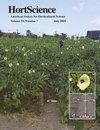Feasibility of Using Pulse Drip Irrigation for Increasing Growth, Yield, and Water Productivity of Red Raspberry
IF 1.5
3区 农林科学
Q2 HORTICULTURE
引用次数: 0
Abstract
Pulse irrigation, the practice of applying water in small doses over time, is known to reduce deep percolation and runoff and, relative to irrigating in single continuous applications, can increase plant growth and production by supplying water and nutrients at an optimal rate. The objective of the present study was to determine whether pulse irrigation was beneficial in red raspberry (Rubus idaeus L. ‘Wakefield’). Treatments included continuous or pulse drip irrigation and were evaluated for three growing seasons (2018–20) in a commercial field with silt loam soil. Continuous irrigation was applied up to 4 hours/day, whereas pulse irrigation was programmed to run for 30 minutes every 2 hours, up to eight times/day, using the same amount of water as the continuous treatment. Pulsing improved soil water availability relative to continuous irrigation and, by the second and third year, increased fruit production by 1210 to 1230 kg·ha−1, which, based on recent market prices, was equivalent to $2420 to $2460/ha per year. Much of this yield increase occurred during the latter 3 to 4 weeks of the harvest season and was primarily due to larger fruit size during the second year and more berries per plant during the third year. In 1 or both years, pulse irrigation also produced more canopy cover, larger cane diameters, and higher concentrations of Mg and S in the leaves than continuous irrigation, but it reduced K and B in the soil and had variable effects on sugar-to-acid ratio in the berries. On the basis of these results, pulsing appears to be an effective means of irrigating raspberry plants in sandy or silty loam soils, but more research is needed to determine whether it is useful technique in heavier soil types.利用脉冲滴灌提高红树莓生长、产量和水分生产率的可行性
众所周知,脉冲灌溉是在一段时间内小剂量供水的做法,可减少深层渗漏和径流,与单次连续灌溉相比,脉冲灌溉能以最佳速率供水和提供养分,从而提高植物的生长和产量。本研究的目的是确定脉冲灌溉对红树莓(Rubus idaeus L. 'Wakefield')是否有益。处理包括连续灌溉或脉冲滴灌,并在淤泥质壤土的商业田地中进行了三个生长季(2018-20 年)的评估。连续灌溉的时间长达每天 4 小时,而脉冲灌溉则设定为每 2 小时运行 30 分钟,最多每天 8 次,使用的水量与连续灌溉相同。与连续灌溉相比,脉冲灌溉提高了土壤水分利用率,到第二年和第三年,水果产量增加了 1210 至 1230 千克/公顷,根据最近的市场价格,相当于每年 2420 至 2460 美元/公顷。大部分增产发生在收获季节的后 3 至 4 周,主要原因是第二年果实更大,第三年每株果实更多。与连续灌溉相比,脉冲灌溉在其中一年或两年中还能产生更多的冠层覆盖、更大的甘蔗直径以及更高的叶片镁和硒浓度,但脉冲灌溉会减少土壤中的钾和硼,并对浆果中的糖酸比产生不同的影响。根据上述结果,脉冲灌溉似乎是在沙质或淤泥质壤土中灌溉树莓植株的一种有效方法,但还需要更多的研究来确定这种技术在较重的土壤类型中是否有用。
本文章由计算机程序翻译,如有差异,请以英文原文为准。
求助全文
约1分钟内获得全文
求助全文
来源期刊

Hortscience
农林科学-园艺
CiteScore
3.00
自引率
10.50%
发文量
224
审稿时长
3 months
期刊介绍:
HortScience publishes horticultural information of interest to a broad array of horticulturists. Its goals are to apprise horticultural scientists and others interested in horticulture of scientific and industry developments and of significant research, education, or extension findings or methods.
 求助内容:
求助内容: 应助结果提醒方式:
应助结果提醒方式:


